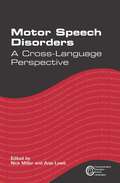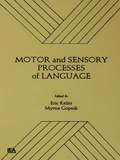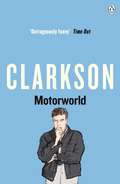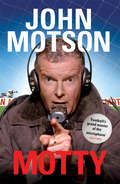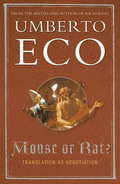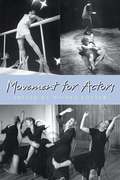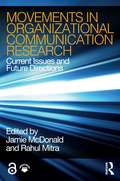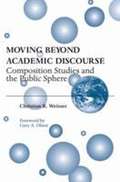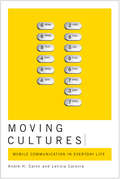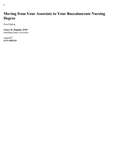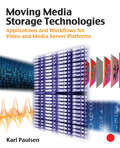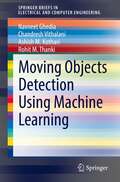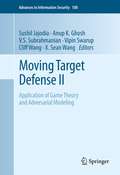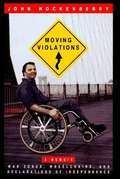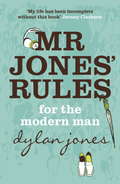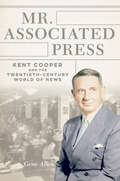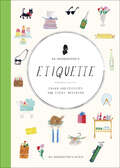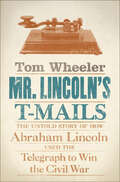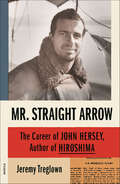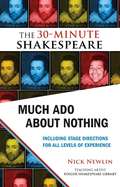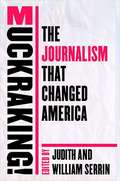- Table View
- List View
Motor Speech Disorders
by Anja Lowit Nick MillerMotor speech disorders are a common accompaniment of a whole range of neurological conditions, from stroke, brain injury and Parkinson's disease through to many rarer conditions. This book aims to aid understanding of the nature of motor speech disorders from a cross-language perspective, in contrast to the largely English-centric nature of research and practice recommendations to date. The book looks not just at how these motor speech disorders are assessed and treated in other countries, but also examines how underlying speech impairments differ according to the language someone speaks. The book studies the underlying neurological, neurophysiological and neurophonetic characteristics of motor speech disorders in different language contexts, and discusses the implications these have for clinical rehabilitation. This significantly adds to debates around the theoretical understanding and clinical management of motor speech disorders.
Motor and Sensory Processes of Language (Neuropsychology and Neurolinguistics Series)
by Eric Keller Myrna GopnikPublished in 1987, Motor and Sensory Processes of Language is a valuable contribution to the field of Cognitive Psychology.
Motorworld
by Jeremy ClarksonJeremy Clarkson invites us to Motorworld, his take on different cultures and the cars that they drive.There are ways and means of getting about that don't involve four wheels, but in this slice of vintage Clarkson, Jeremy isn't much interested in them.Back in 1996, he took himself off to twelve countries (okay, eleven - he goes to America twice) in search of the hows, whys and wherefores of different nationalities and their relationships with cars. There were a few questions he needed answers to:* Why, for instance, is it that Italians are more interested in looking good than looking where they are going?* Why do Indians crash a lot?* How can an Arab describe himself as 'not a rich man' with four of the world's most expensive cars in his drive? * And why have the otherwise neutral Swiss declared war on the car?From Cuba to Iceland, Australia to Vietnam, Japan to Texas, Jeremy Clarkson tells us of his adventures on and off four wheels as he seeks to discover just what it is that makes our motorworld tick over. _____________Praise for Jeremy Clarkson:'Brilliant . . . laugh-out-loud' Daily Telegraph'Outrageously funny . . . will have you in stitches' Time Out'Very funny . . . I cracked up laughing on the tube' Evening Standard
Motty: Forty Years in the Commentary Box
by John MotsonFrom Ronnie Radford to Wayne Rooney, John Motson's knowledge and passion for football are unrivalled. In Motty, he shares his story for the first time and guides us through a career which has spanned forty years and over 2,000 matches. From reporting on the exploits of the giant-killing Hereford team in the 1972 FA Cup that made his name on Match of the Day, to the estimated twenty-million viewers who tuned in to his commentary on England's match with Portugal at the 2006 World Cup, Motson's time in the commentary box has delivered some unforgettable anecdotes. In dozens of fascinating behind-the-scenes stories, we hear about the greatest football matches he has watched and the greatest players and managers he has been privileged to know. Many of them are football icons; Bill Shankly, Alex Ferguson, Brian Clough, Alf Ramsey, and Matt Busby, amongst countless others.Motty is essential reading for anyone who has grown up with the undisputed voice of football.
Mouse or Rat?: Translation As Negotiation
by Umberto Eco'Translation is always a shift,not between two languages but between two cultures. A translator must take into account rules that are not strictly linguistic but, broadly speaking, cultural.' Umberto Eco is of the world's most brilliant and entertaining writers on literature and language. In this accessible and dazzling study, he turns his eye on the subject of translations and the problems the differences between cultures can cause. The book is full of little gems about mistranslations and misunderstandings.For example when you put 'Studies in the logic of Charles Sanders Peirce' through an internet translation machine, it becomes 'Studies in the logic of the Charles of sandpaper grinding machines Peirce'. In Italian 'ratto' has no connotation of 'contemptible person' but denotes speed ('you dirty rat' could take on a whole new meaning!) What could be a weighty subject is never dull, fired by Eco's immense wit and erudition, providing an entertaining read that illuminates the process of negotation that all translators must make.
Mouse or Rat?: Translation as Negotiation
by Prof Umberto EcoFrom the world-famous author of THE NAME OF THE ROSE, an illuminating and humorous study on the pleasures and pitfalls of translation.'Translation is always a shift, not between two languages but between two cultures. A translator must take into account rules that are not strictly linguistic but, broadly speaking, cultural.'Umberto Eco is of the world's most brilliant and entertaining writers on literature and language. In this accessible and dazzling study, he turns his eye on the subject of translations and the problems the differences between cultures can cause. The book is full of little gems about mistranslations and misunderstandings.For example when you put 'Studies in the logic of Charles Sanders Peirce' through an internet translation machine, it becomes 'Studies in the logic of the Charles of sandpaper grinding machines Peirce'. In Italian 'ratto' has no connotation of 'contemptible person' but denotes speed ('you dirty rat' could take on a whole new meaning!)What could be a weighty subject is never dull, fired by Eco's immense wit and erudition, providing an entertaining read that illuminates the process of negotiation that all translators must make.
Move On: Adventures in the Real World
by Linda EllerbeeEllerbee gives details on how she moved from working with ABC to CNN.
Movement for Actors
by Nicole PotterTeachers and practitioners offer actors, directors, and students both practical suggestions and inspiration on how to tell the story through the body. Body basics, beyond glove and fan, and schools of thought are among the themes.
Movements in Organizational Communication Research: Current Issues and Future Directions
by Jamie McDonald Rahul MitraMovements in Organizational Communication Research is an essential resource for anyone wishing to become familiar with the current state of organizational communication research and key trends in the field. Seasoned organizational communication scholars will find that the book provides unique insights by way of the intergenerational dialogue that is found in the book, as well as the contributors’ stories about their scholarly trajectories. Those who are new to the field will find that the book enables them to familiarize themselves with the field and become a part of the organizational communication scholarly community in an inviting and accessible way. Key features of the book include: A review of current issues and future directions in 13 topical areas of organizational communication research. Intergenerational dialogue and collaboration between both established and emerging scholars in their specialty areas. Reflections by the authors on their scholarly trajectories and how they became a part of the field. Discussion questions at the end of each chapter that prompt reflections and debate. The book also features online resources for instructors: Sample course syllabus Suggested case studies from the book Cases in Organization and Managerial Communication to align with this book’s chapters The book is recommended as the anchor text for introductory graduate-level courses and upper-level undergraduate courses in organizational communication. It is also an excellent supplementary text for advanced doctoral-level courses in organizational communication, and courses in related fields such as organization studies, organizational behavior, and management.
Moving Beyond Academic Discourse: Composition Studies And The Public Sphere
by Christian R. WeisserMoving student writing beyond academic discourse and into larger public spheres is a difficult task, but Christian R. Weisser’s study challenges composition instructors to do just that. This highly accessible book does what no other study has attempted to do: place the most current, cutting-edge theories and pedagogies in rhetoric and composition in their intellectual and historical contexts, while at the same time offering a unique, practical theory and pedagogy of public writing for use both inside and outside of the classroom. By positing a theory of the public for composition studies, one which envisions the public sphere as a highly contested, historically textured, multilayered, and sometimes contradictory site, Weisser offers a new approach to the roles that compositionists might assume in their attempts to initiate progressive political and social change. After first providing a historical context that situates composition’s recent interest in public writing, Weisser next examines recent theories in composition studies that consider writing an act of social engagement before outlining a more complex theory of the public based on the work of Jürgen Habermas. The resulting re-envisioning of the public sphere expands current conversations in rhetoric and composition concerning the public. Weisser concludes with a holistic vision that places greater political and social import on addressing public issues and conversations in the composition classroom and that elucidates the role of the public intellectual as it relates specifically to compositionists in postmodern society.
Moving Cultures
by Letizia Caronia André H. CaronAndré Caron and Letizia Caronia look at teenagers' use of text messaging to chat, flirt, and gossip. They find that messaging among teens has little to do with sending shorthand information quickly. Instead, it is a verbal performance through which young people create culture. Moving Cultures argues that teenagers have domesticated and reinterpreted this technology.
Moving From Your Associate To Your Baccalaureate Nursing Degree
by Nancy DuphilyMoving from Your Associate to Your Baccalaureate Nursing Degree is designed to welcome and celebrate the experience, knowledge, and expertise practicing nurses bring to the academic table as they pursue a baccalaureate degree in nursing. The book aligns with Institute of Medicine competencies and emphasizes leadership and management, ethics and decision-making, critical thinking, evidence-based practice, caring, collaboration, communication, and self-reflective skills, all supported by literature and practice examples.
Moving Media Storage Technologies: Applications & Workflows for Video and Media Server Platforms
by Karl PaulsenComplex media storage computer systems are employed by broadcasters, digital cinemas, digital signage, and other business and entertainment venues to capture, store and retrieve moving media content on systems that will preserve the original integrity of the content over time and technological transition. This book provides detailed information related to the concepts, applications, implementation and interfaces of video file servers, intelligent storage systems, media asset management services, content distribution networks, and mission critical platforms. A tutorial and case example approach is taken to facilitate a thorough understanding of the technologies, using numerous illustrations, tables and examples. The text and appendices are designed to provide easy to access valuable reference and historical information. .A focus on the media serving concepts and principles employed at the enterprise level .Practical and technological summaries of the applications and linkages between media asset management and storage technologies for studio, television, and media production workflows .Illustrations, standards, tables, and practical summaries serve as handy reference tools
Moving Objects Detection Using Machine Learning (SpringerBriefs in Electrical and Computer Engineering)
by Rohit M. Thanki Ashish M. Kothari Navneet Ghedia Chandresh VithalaniThis book shows how machine learning can detect moving objects in a digital video stream. The authors present different background subtraction approaches, foreground segmentation, and object tracking approaches to accomplish this. They also propose an algorithm that considers a multimodal background subtraction approach that can handle a dynamic background and different constraints. The authors show how the proposed algorithm is able to detect and track 2D & 3D objects in monocular sequences for both indoor and outdoor surveillance environments and at the same time, also able to work satisfactorily in a dynamic background and with challenging constraints. In addition, the shows how the proposed algorithm makes use of parameter optimization and adaptive threshold techniques as intrinsic improvements of the Gaussian Mixture Model. The presented system in the book is also able to handle partial occlusion during object detection and tracking. All the presented work and evaluations were carried out in offline processing with the computation done by a single laptop computer with MATLAB serving as software environment.
Moving Target Defense II
by Sushil Jajodia Cliff Wang V. S. Subrahmanian Anup K. Ghosh X. Sean Wang Vipin SwarupOur cyber defenses are static and are governed by lengthy processes, e.g., for testing and security patch deployment. Adversaries could plan their attacks carefully over time and launch attacks at cyber speeds at any given moment. We need a new class of defensive strategies that would force adversaries to continually engage in reconnaissance and re-planning of their cyber operations. One such strategy is to present adversaries with a moving target where the attack surface of a system keeps changing. Moving Target Defense II: Application of Game Theory and Adversarial Modeling includes contributions from world experts in the cyber security field. In the first volume of MTD, we presented MTD approaches based on software transformations, and MTD approaches based on network and software stack configurations. In this second volume of MTD, a group of leading researchers describe game theoretic, cyber maneuver, and software transformation approaches for constructing and analyzing MTD systems. Designed as a professional book for practitioners and researchers working in the cyber security field, advanced -level students and researchers focused on computer science will also find this book valuable as a secondary text book or reference.
Moving Violations: War Zones, Wheelchairs and Declarations of Independence
by John HockenberryParaplegic newscaster Hockenberry speaks as a thought-provoking journalist, an insightful iconoclast and a man defined, but never confined by a wheelchair.
Moyers on America: A Journalist and His Times
by Bill MoyersThe Peabody Award–winning journalist shares stories and insights into our country and the crises we face in an &“eloquent selection of . . . commentaries&” (Publishers Weekly, starred review). Millions of Americans have invited Bill Moyers into their homes over the years. With television programs covering topics from American history, politics, and religion to the role of media and the world of ideas, he has become one of America&’s most trusted journalists. Now Moyers presents, for the first time, a powerful statement of his own personal beliefs—political and moral. Combining illuminating forays into American history with candid comments on today&’s politics, Moyers delivers perceptive and trenchant insights into the American experience. From his early years as a Texas journalist to his role as a founding organizer of the Peace Corps, top assistant to President Lyndon Johnson, publisher of Newsday, senior correspondent and analyst for CBS News, and producer of many of public television&’s groundbreaking series, Moyers has been actively engaged in some of the most volatile episodes of the past fifty years. Drawing from these experiences, he shares his unique understanding of American politics and an enduring faith in the nation&’s promise and potential. Whether reflecting on today&’s media climate, corporate scandals, or religious and political upheavals, Moyers on America recovers the hopes of the past to establish their relevance for the present. &“Not only a good reporter . . . a first-rate storyteller.&” —The Boston Globe
Mr Jones' Rules for the Modern Man
by Dylan JonesA witty, stylish and indispensable guide to being a modern man. It is tough being a man in the twenty-first century. First there are the big dilemmas, like how to get a pay rise and how to suck up to your boss. Then there are the minor irritations: how do you beat jet-lag, and how do you stop your trousers sliding off their hangers? And finally there are all those things you ought to know, but don't: how to jump-start a car, how to buy lingerie, how to stop smoking, how to tie a Windsor Knot, how to behave at a lap-dancing club ... the list is endless. Fear not. In Mr Jones Rules, the highly respected editor of GQ magazine, draws on his wealth of experience to give the final answer to these questions and more. It will be the must-have present for every husband, boyfriend and son this Christmas.
Mr Jones' Rules for the Modern Man
by Dylan JonesA witty, stylish and indispensable guide to being a modern man. It is tough being a man in the twenty-first century. First there are the big dilemmas, like how to get a pay rise and how to suck up to your boss. Then there are the minor irritations: how do you beat jet-lag, and how do you stop your trousers sliding off their hangers? And finally there are all those things you ought to know, but don't: how to jump-start a car, how to buy lingerie, how to stop smoking, how to tie a Windsor Knot, how to behave at a lap-dancing club ... the list is endless. Fear not. In Mr Jones Rules, the highly respected editor of GQ magazine, draws on his wealth of experience to give the final answer to these questions and more. It will be the must-have present for every husband, boyfriend and son this Christmas.
Mr. Associated Press: Kent Cooper and the Twentieth-Century World of News (The History of Media and Communication)
by Gene AllenBetween 1925 and 1951, Kent Cooper transformed the Associated Press, making it the world’s dominant news agency while changing the kind of journalism that millions of readers in the United States and other countries relied on. Gene Allen’s biography is a globe-spanning account of how Cooper led and reshaped the most important institution in American--and eventually international--journalism in the mid-twentieth century. Allen critically assesses the many new approaches and causes that Cooper championed: introducing celebrity news and colorful features to a service previously known for stodgy reliability, pushing through disruptive technological innovations like the instantaneous transmission of news photos, and leading a crusade to bring American-style press freedom--inseparable from private ownership, in Cooper’s view--to every country. His insistence on truthfulness and impartiality presents a sharp contrast to much of today’s fractured journalistic landscape. Deeply researched and engagingly written, Mr. Associated Press traces Cooper’s career as he built a new foundation for the modern AP and shaped the twentieth-century world of news.
Mr. Boddington's Etiquette: Charm and Civility for Every Occasion
by Mr. Boddington's StudioA witty and eloquent guide to traditional etiquette in modern society, from correspondence and gifts to table manners and life about town.My dears, navigating social situations in the modern world can be so complicated! But you needn’t fuss. Mr. Boddington provides impeccable etiquette advice on the proper way to comport oneself on any occasion.Inside, please find all the dos and don’ts for:How to word a wedding invitationWhen and how to write a thank-you cardWhom to tip (and how much)How to thank the hostess of a dinner partyAnd much more!From daily niceties to the hard-to-remember rules of polite society, Mr. Boddington provides all the answers with his signature wit and charm.
Mr. Lincoln's T-Mails: The Untold Story of How Abraham Lincoln Used the Telegraph to Win the Civil War
by Tom WheelerThis “intriguing” look at the sixteenth president’s telegraph usage during the Civil War “revisits a familiar hero, but does so from an utterly new perspective” (Ken Burns).The Civil War was the first “modern war.” Because of rapid changes in American society, Abraham Lincoln became president of a divided United States during a period of technological and social revolution. Among the many modern marvels that gave the North an advantage was the telegraph, which Lincoln used to stay connected to the forces in the field in almost real time.No leader in history had ever possessed such a powerful tool to gain control over a fractious situation. An eager student of technology, Lincoln (the only president to hold a patent) had to learn to use the power of electronic messages. Without precedent to guide him, Lincoln began by reading the telegraph traffic among his generals. Then he used the telegraph to supplement his preferred form of communication—meetings and letters. He did not replace those face-to-face interactions. Through this experience, Lincoln crafted the best way to guide, reprimand, praise, reward, and encourage his commanders in the field.Written by a former FCC chairman, Mr. Lincoln’s T-Mails tells a big story within a small compass—both an elegant work of history and a timeless lesson in leadership. By paying close attention to Lincoln’s “lightning messages,” we see a great leader adapt to a new medium. No reader of this work of history will be able to miss the contemporary parallels. Watching Lincoln carefully word his messages—and follow up on those words with the right actions—offers a striking example for those who spend their days tapping out notes on their various devices.“Mr. Lincoln’s T-Mails shines. . . . an accessible jaunt through this formative American event.” —USA Today“Wheeler shows a Lincoln groping for a best-use of new technology and learning the limitations of the ‘killer app.’”—Booklist“Altogether captivating.” —Harold Holzer, author of Brought Forth on This Continent: Abraham Lincoln and American Immigration
Mr. Straight Arrow: The Career of John Hersey, Author of Hiroshima
by Jeremy TreglownA monumental reevaluation of the career of John Hersey, the author of HiroshimaFew are the books with as immediate an impact and as enduring a legacy as John Hersey’s Hiroshima. First published as an entire issue of The New Yorker in 1946, it was serialized in newspapers the world over and has never gone out of print. By conveying plainly the experiences of six survivors of the 1945 atomic bombing and its aftermath, Hersey brought to light the magnitude of nuclear war. And in his adoption of novelistic techniques, he prefigured the conventions of New Journalism. But how did Hersey—who was not Japanese, not an eyewitness, not a scientist—come to be the first person to communicate the experience to a global audience?In Mr. Straight Arrow, Jeremy Treglown answers that question and shows that Hiroshima was not an aberration but was emblematic of the author’s lifework. By the time of Hiroshima’s publication, Hersey was already a famed war writer and had won a Pulitzer Prize for Fiction. He continued to publish journalism of immediate and pressing moral concern; his reporting from the Freedom Summer and his exposés of the Detroit riots resonate all too loudly today. But his obsessive doubts over the value of his work never ceased. Mr. Straight Arrow is an intimate, exacting study of the achievements and contradictions of Hersey’s career, which reveals the powers of a writer tirelessly committed to truth and social change.
Much Ado About Nothing: The 30-Minute Shakespeare
by Nick NewlinPlanning a school or amateur Shakespeare production? The best way to experience the plays is to perform them, but getting started can be a challenge: The complete plays are too long and complex, while scene selections or simplified language are too limited."The 30-Minute Shakespeare" is a new series of abridgements that tell the "story" of each play from start to finish while keeping the beauty of Shakespeare's language intact. Specific stage directions and character suggestions give even inexperienced actors the tools to perform Shakespeare with confidence, understanding, and fun!This cutting of Shakespeare's utterly charming and popular comedy MUCH ADO ABOUT NOTHING features five key scenes, including Beatrice and Benedick's classic initial word-battle, and the uproarious hide-and-seek deception of the two "lovers." The next scenes are the brutal rejection of Hero at the altar by a deceived Claudio and the timeless manhandling of the English language by the bumbling constable Dogberry. In the fifth and final scene, Shakespeare resolves the play's conflicts and confusions, and love reigns again. This cutting really tells the story, and includes some sidesplitting stage business, particularly the back-and-forth physical and verbal parrying between Benedick and Beatrice.The edition also includes an essay by editor Nick Newlin on how to produce a Shakespeare play with novice actors, and notes about the original production of this abridgement at the Folger Shakespeare Library's annual Student Shakespeare Festival.
Muckraking: The Journalism that Changed America
by Judith SerrinMuckraking! brings together the greatest moments of American journalism. Supplying historical context and critical commentary, the book also includes a selection of influential photographs and illustrations. By turns compelling and shocking, Muckraking! is an anthology for anyone who feels passionate about the heights that journalism can climb or its ability to illuminate the darkest depths.
